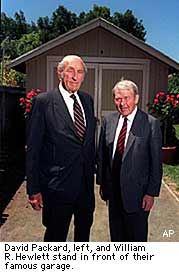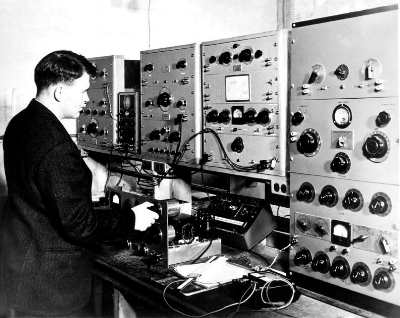Next reunion 25-27 April 2003 |
|
 |
Computers and stuffSam Houliston |
 |
Everybody has seen at least one piece of equipment with the names Hewlett Packard on it, but just who was Hewlett and who was Packard.
Like Mr Rolls and Mr Royce, these two blokesí names have come to represent equipment of the highest quality, and where Rolls Royce is now represented and immediately recognizable by the letters RR, the Hewlett Packard brand is represented by the letters HP.
William R. Hewlett was born in Ann Arbor, Mich., in 1913 but grew up in California where his father was a professor of medicine at Stanford University. Hewlett studied engineering at Stanford Uni, and it was here that he met and became friends with David Packard, another engineering student. Both graduated in 1934, with Packard going to work for General Electric in New York and Hewlett going on and earning a master's degree at Massachusetts Institute of Technology. A few years later, both were back together and decided to start their own company in a rented garage. They actually tossed a coin to see whose name would go first, it could have been Packard Hewlett.
They formalized their partnership on New Year's Day 1939 but it was Hewlett who was the engineering brain of the team. From its humble beginning the company grew into the multibillion-dollar manufacturer of high-quality computers and scientific instruments. Hewlett ranked among his greatest accomplishments HPís management style that still serves as a model for other companies. During his time at the helm, and despite his position and great wealth, he lacked all pretence and delighted in working on new products side-by-side with employees or playing penny poker with them. Hewlett stepped down as HP's president in 1977. When he died in 2001, Hewlett was worth an estimated US$9 billion. David Packard also died a rich man in 1996, at age 83
 |
At an interview with reporters in 1987, Hewlett recalled the early years of the company, "In the beginning, we did anything to bring in a nickel, we had a bowling lane foul line indicator, we had a thing that would make a urinal flush automatically as soon as a guy came in front of it and we had a shock machine to make people lose weight."
The young company's first success was an audio oscillator, a device to test sound equipment. Bill Hewitt's study of negative feedback resulted in a breakthrough development allowing the production of their resistance-capacity audio oscillator (HP 200A). The HP Model 200A was so named because they thought the name would make them look like they'd been around for awhile. The oscillator used an electric light bulb as part of the circuit, providing variable resistance, a breakthrough in oscillator design. The principle of feedback provided the foundation for other early HP products such as an harmonic wave analyser and several distortion analysers. Walt Disney ordered eight Model 200B oscillators which were used to develop the soundtrack for Fantasia.
In 1951 the company invented the high-speed frequency counter (HP 524A) which greatly reduced the time required (from about 10 minutes to one or two seconds) to measure high frequencies. Radio stations used the HP 524A to accurately set frequencies to comply with FCC regulations for frequency stability. HP's first computer, the HP 2116A was introduced in 1966. It was developed as a versatile instrument controller for HP's growing family of programmable test and measurement products. Featuring an early version of "plug and play," it interfaced with a wide number of standard laboratory instruments, allowing customers to computerize their instrument systems. In 1966 it was the largest single mechanical package HP had built, and it marked HP's first use of integrated circuits.
In 1966, most computers had to be pampered in air-conditioned rooms on spring-loaded floors. HP decided that the 2116A should pass the same environmental tests as the instruments it would team with and therefore should be rugged and reliable. This approach transformed the 2116A into the first go-anywhere, do-anything computer. The first 2116A was sold to an Oceanographic Institute and was used aboard a research vessel in a salt-air environment for more than 10 years. It had (for itís time a colossal) 4K of magnetic core memory which was expandable to 32K and cost from $25,000 to $50,000, (1966 US dollars) depending on options.
A Local Area Network in Australia - a LAN down under |

